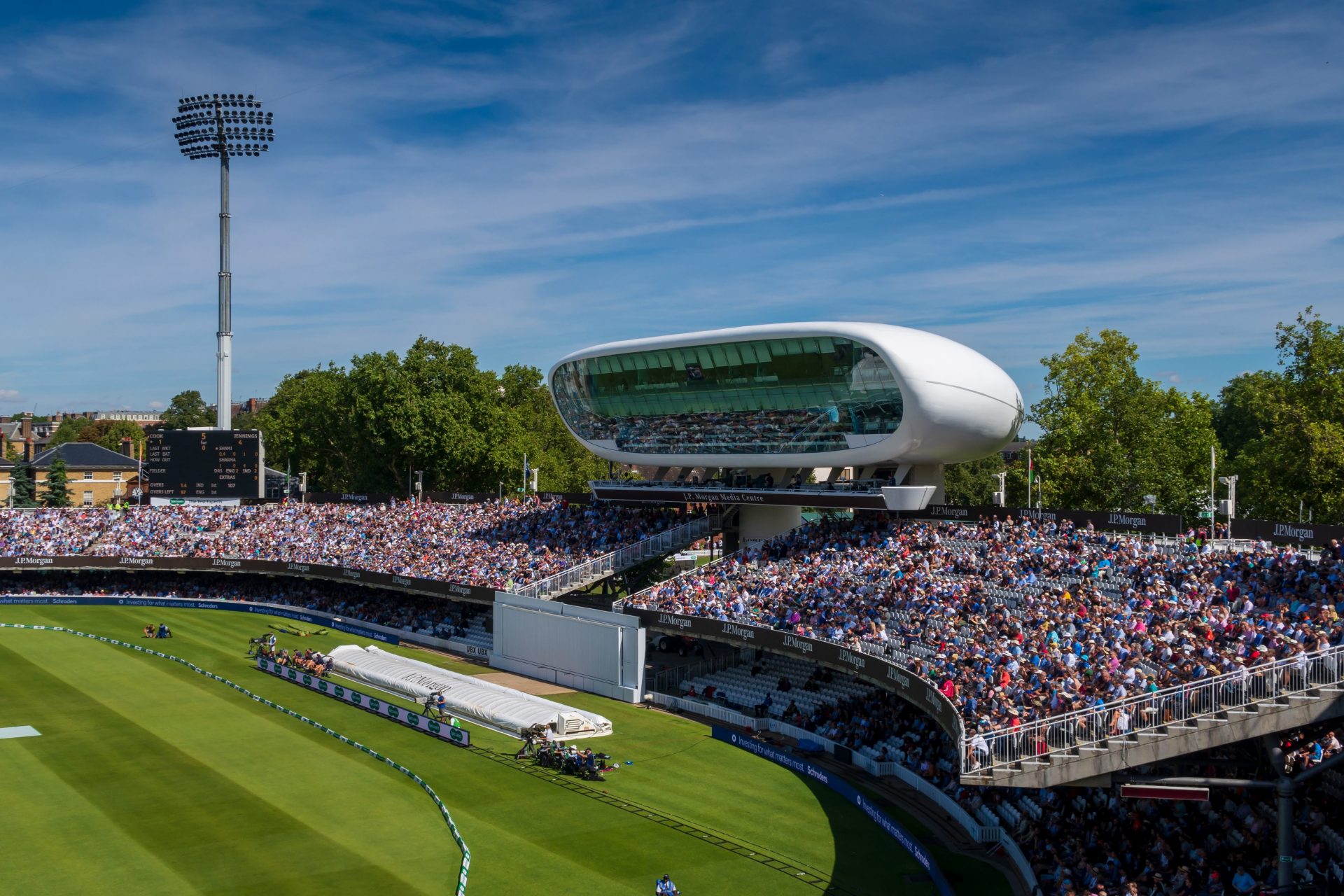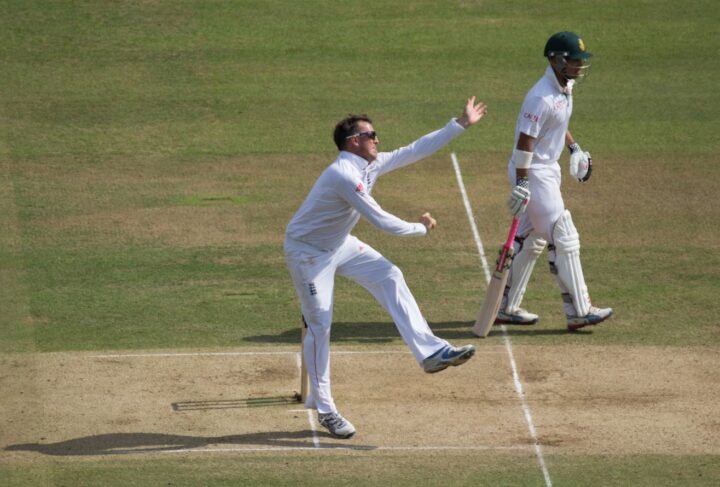The issue of class is woven into the history of cricket like no other sport.
As a non-contact game, it was more socially acceptable for the English upper classes to play alongside the working class. It was a shared sporting endeavour but without the potentially awkward physicality of rugby or football.
Thus cricket helped forge the powerful English myth of social cohesion across class divisions: the blacksmith bowling to the Lord of the Manor on the village green.
Snobbery
Unlike the split alongside class lines that occurred between Rugby League and Rugby Union, cricket held together. But this unity was only possible by the enforcement of a division between Amateurs (‘Gentlemen’) and Professionals (‘Players’). In this way snobbery and elitism were baked in to the game.
Amateurs had different changing rooms, different gates to enter the field, ate at different tables, always had their full initials on the scorecard, were addressed as ‘sir’ and had to be captain. And of course, amateurs were not supposed to be paid to play. Except they were: it was just called ‘expenses’.
Hypocrisy
The division was full of hypocritical nonsense even back in the Victorian era. W.G. Grace, ostensibly an amateur, earnt more money from cricket than anyone. Yet despite blatant ‘shamateurism’ the class division was fiercely defended and was only abandoned in the 1960s.
The issue of class is a significant theme in any book about cricket history. Recently, as a birthday present, I was given a copy of the famous Wisden Cricketers’ Almanac 1972, the year I was born. It includes coverage of schools and university cricket, but this means only private schools and only two universities: Oxford and Cambridge.
When I was at Hull University (the third great English university) in the early 1990s, we played up to this history and every year held a ‘Gentlemen v Players’ match: the Gents being from fee-paying schools and the Players from state schools. It was part-fun and ironic but was always a genuinely competitive match (with lots of banter and plenty of inverted snobbery).
Inclusive
In recent years cricket has become more inclusive in some ways: there is more investment in cricket for women, for people with disabilities and in new forms of the game to engage younger people. And despite high-profile problems, I think there is more understanding across racial divides too.
But in other ways the game has become far more elitist. It has become a game almost entirely for children from private schools. Playing fields have been sold off and a lack of investment has meant cricket has largely disappeared from state schools.
Unrepresentative
In a recent England team, 9 out of the 11 were privately educated. That is 82% of a team representing a country where only 7% attend fee-paying schools.
In addition, the removal of cricket from free-to-watch TV has further insulated the game away from ordinary people.
The decision to put cricket behind a pay-wall was great news for a few and a complete disaster for the rest. This was the worst decision ever made by English Cricket, and no amount of expensive marketing or new formats like The Hundred can breach the gap created.
Flintoff’s Field of Dreams
And it is into this space that former England All-Rounder, Andrew ‘Freddie’ Flintoff (who some may know better from Top Gear) has stepped with an inspiring new TV show Freddie Flintoff’s Field of Dreams.
The programme follows Flintoff’s efforts to engage kids from his home town of Preston, Lancashire, to take up cricket. He goes to schools, streets and youth clubs and finds whole rooms of children who cannot name one player in the England team. Names like Joe Root or James Anderson mean nothing to them. In the past, cricket has been popular in these communities but now its just seen as a posh game for rich kids.
Freddie forges a team out of boys who have never played, some of whom have been excluded from school, been homeless and been asylum seekers. It is genuinely uplifting, moving and inspiring.
First-hand
I know first-hand how much state-school children can love cricket if they are given the opportunity. I took over managing a junior team at Addiscombe CC who only had 5 players at the time. My sons encouraged school friends from Streatham to join and we forged a make-shift team including many who had never played before.
At the start, we got battered frequently and came bottom of the league for a few seasons. We were also on the receiving end of a fair few snobby comments and entitled attitudes from other clubs.
Proudest moment
But we had a lot of fun and the team steadily improved. In our final season together, a combination of great performances and luck meant we ended up winning our league. I was gobsmacked. In 35 years of playing cricket, it was my proudest moment by far.
Cricket is an amazing game for all young people to be able to play. And just like he did as a player, Freddie Flintoff is setting an inspiring example for others to follow.
Jon Kuhrt
You can read more of John’s work on his blog, Grace & Truth.









I came through my cricketing apprenticeship in the 60’s and 70’s. I can assure you what school you went to was pretty much the defining factor then. Even if you were lucky enough to have competitive cricket between schools the scouts wouldn’t come unless they heard about outstanding achievement. The same applied to clubs if you weren’t in the right leagues. It’s sad that cricket hasn’t really moved on these last 50 years but nothing Flintoff had to say should come as a surprise. I have watched public school cricket over the years as my partner worked as a caterer for one and was rarely impressed by the standard, though everyone had the latest PPI and kit.
It’s hard to see a short term solution as you never see kids playing it in the local parks anymore and clubs are struggling to stay afloat and operate more than a couple of teams. There’s little evidence to suggest that sport generally is attracting increased participation despite a recent home Olympics. It will be interesting to see if The Lioness factor attracts more young women into football or if schools and clubs remain rooted as they are.
The “Lioness (not gender neutral) Factor” will be like the January factor: loads of people take out gym membership, find it’s just not as easy as they think, and are gone by mid February.
Jon
An interesting piece. I have often said that class distinction blighted many more cricketing careers than racial prejudice ever did. One point on scorecards, the difference was surely that amateurs were listed with their initials first, whereas professionals were listed with their surnames first. There was the famous case at Lord’s when a loudspeaker announcement drew attention to an error on the score card and pointed out that “ ‘F.J. Titmus’ should read ‘Titmus F. J.’ “
I wish Freddie every success – a great initiative.
Its interesting to see how the importance of class became ingrained in cricket too, and travelled with it to other countries – for example, its not as bad in NZ and (I suspect) in Australia, but it is still there. In NZ for example, the school you go to still counts massively. Pathways narrow very early on as Major Associations (equivalent of Counties) pay much more attention to a few preferred schools. Partly that is ‘class’, but also partly geography – few look much beyond their noses. There are moves from NZ Cricket to overcome this by removing/reducing the role/importance of younger rep programmes, but many of the major associations play lip service at best
Then extend this class argument to women, and its easy to see why the chain has been dragged on involving 50% of the population in this great game. If amateurs were submissive to gentlemen, ladies were a distant 3rd.
Oscar
I wouldn’t flatter what I did by calling it an analysis, but I did look at the women’s side last year and it seemed to me that the public/state demarcation was nothing like as marked as in the men’s game. The main common feature seemed to be that many of the successful women were introduced to the game by elder brothers who played club cricket.
Interesting, cheers
I was meaning more the female game as a whole relative to the men’s game,, rather than *within* the female game.
Women’s cricket, generally, was for a long time (and still now to a large degree), seen implicitly or explicitly as a ‘lower class’ than men’s – I’m not talking pay parity etc, just the way administrators treat it.
Yes, that is very true.
In Australia the majority of cricketers come from State schools and that includes those representing Australia.
while reading i thought some things:
that shared with you frnds
The recreation has been historically ruled through the English, who’ve a protracted records of cricketing excellence.
The recreation is likewise extra steeply-priced than maximum different sports activities to play, with system costing up to $3,000 and uniforms costing up to $300.
However, in latest years there was a thrust back in opposition to this elitism with the arrival of Twenty20 cricket.
In this variation of the recreation, suits are decreased from 5 days to 3 hours and every group has simplest 20 overs as opposed to 50; for that reason making it a lot inexpensive for human beings to play.
…except that: it doesn’t. You need the same equipment to play T20 as any other form of the game.
Samuel
Club cricket was never particularly elitist, and the entry level cost not much different from other sports, although it does rise once you start playing seriously. The vast majority of cricket played in this country lasts about half a day and much of it is limited overs – I suspect most recreational cricketers have never played in a match with more than one innings or one going into a second day. Most midweek leagues have been 20 over per side for many years – although played as shorter versions of the longer game. Whatever T20 has brought to the game, I don’t think it has reduced the cost of playing it, or done anything for cricket’s demographic structure.
Well, the biggest “class divide” in English cricket now is between members and non-members. Abolish membership and we can all become “customers”.
Stories like this don’t get pushed by the media unless they are being put to serve the overall agenda. I expect we’ll hear tales of kids playing cricket in the streets as part of the campaign aginst cars because, if you haven’t noticed, they don’t want us going anywhere except by foot and bike.
Alternatively, you must believe that those who’ve presided over the way cricket currently is have suddenly started caring about the problems that they themselves created.
….a third possibility: you could realise that the BBC and the ECB are not in fact the same organisation!
I also think there’s a strong divide between rural/suburban and urban places. Crickonomics has a chapter on this – just 2% of England players are from Manchester, Leeds, Liverpool or Birmingham (in fact, none are from Liverpool – I think) and only 11% Greater London (way below the proportion for football, for instance.
I went to a state school in a fairly rural area and although we barely played cricket at school, lots of (mainly) boys still played it since the area had lots of strong clubs with big youth programmes. Ashes ’05 helped too…
If you go to a city, there are very few ‘central’ clubs with youth set ups – most require travel and joining one is unlikely unless you are connected to a club already through family.
Of course this is isn’t independent from the state/private debate but it seems England players either come from posh schools or big clubs. Also a word on the private figures – players like Root were largely state educated before getting a scholarship at the very end of their schooling.
The Field of Dreams makes a very valid point and has caught a lot of attention. The causes are many. Certainly the Sky Paywall has made a huge difference. The Thatcher policy of selling off playing fields (asset stripping schools for developers), especially in urban areas, another major cause. This continued after her demise.
However not all Counties are the same. Durham is a working class county and its numerous pit villages established cricket as a major recreation activity. Despite the closing of the mines the village cricket teams have survived. The Durham Cricket league like cricket leagues everywhere follow the old County boundaries so Sunderland is in County Durham and so is Gateshead and half of Middlesborough. The old boundaries are the Tyne river and the Tees river. Next door County Northumberland also had a coalfield and the same thing happened. Ashington which has supplied cricketers is a former pit village in Northumberland. I hesitate to say it but Yorkshire had a similar supply of cricketers and it well may be that those clubs have survived also.
The real loss is in schools. The option to play cricket should be part of the school curriculum. Sports and the arts suffered from cuts in the curriculum under Gove and the Tory government. They wanted more science academic subjects taught in State schools so the Humanities suffered also. You know what to do. Write to your MP.
Thank you for this excellent article. Appreciate it!